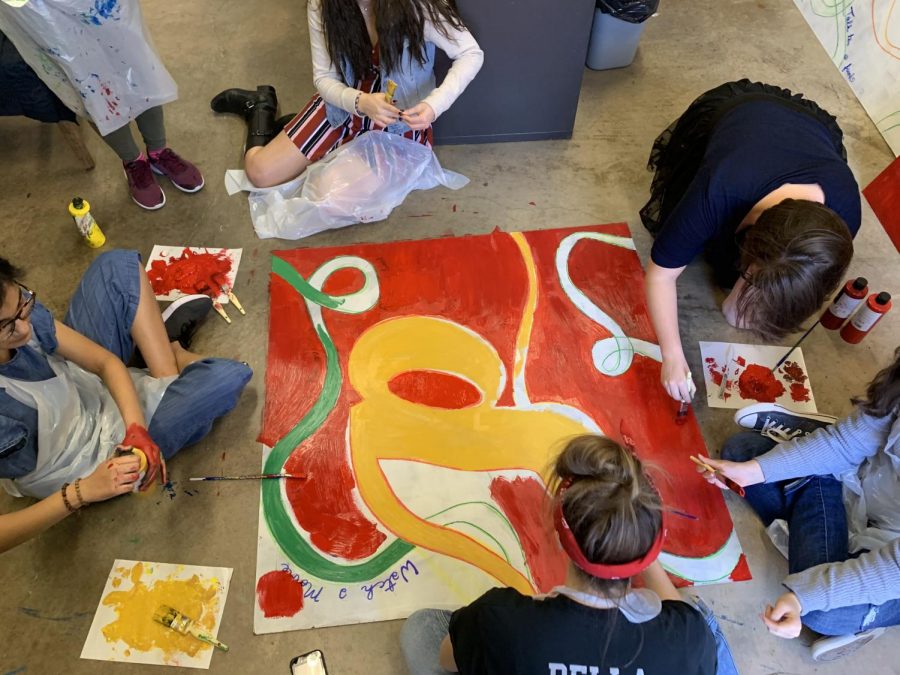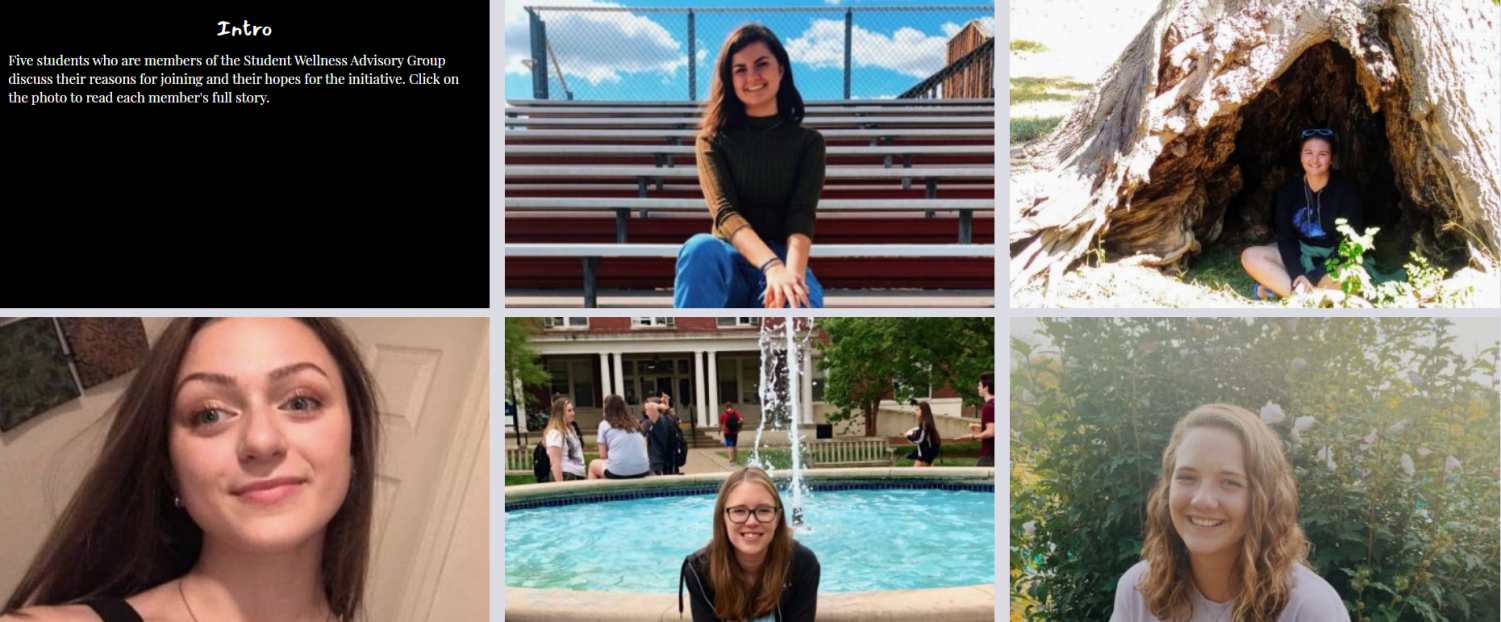Members of the Student Wellness Advisory Group (Seniors Meher Muzaffar, Casey Miller, Danielle Serrao, Bella DePaola, Caroline Waters and Julia Friedhoff) work on a mural to be hung in the new student lounge area in the 800s hallway.
The Fight for Wellness
Hunterdon Central promotes student well being.
June 17, 2020
As part of the district’s Strategic Plan, Hunterdon Central Regional High School has been working to focus on student wellness. After two students took their own lives in the last two years, this focus took on a new urgency.
At the direction of Superintendent Jeffrey Moore, Central has conducted two Climate Surveys, which indicated students didn’t have a strong relationship with their teachers.
“We want to grow the positive attributes in individuals… It all stems from being mindful and regarding what everybody needs,” says Dr. Moore.
This story attempts to profile some of the ways the school is attempting to address the students’ mental health and wellness.
Wellness Initiative Shows ‘HC Cares’
Central brands its aggressive campaign to address student mental and emotional health crisis.
By Lucas Musto
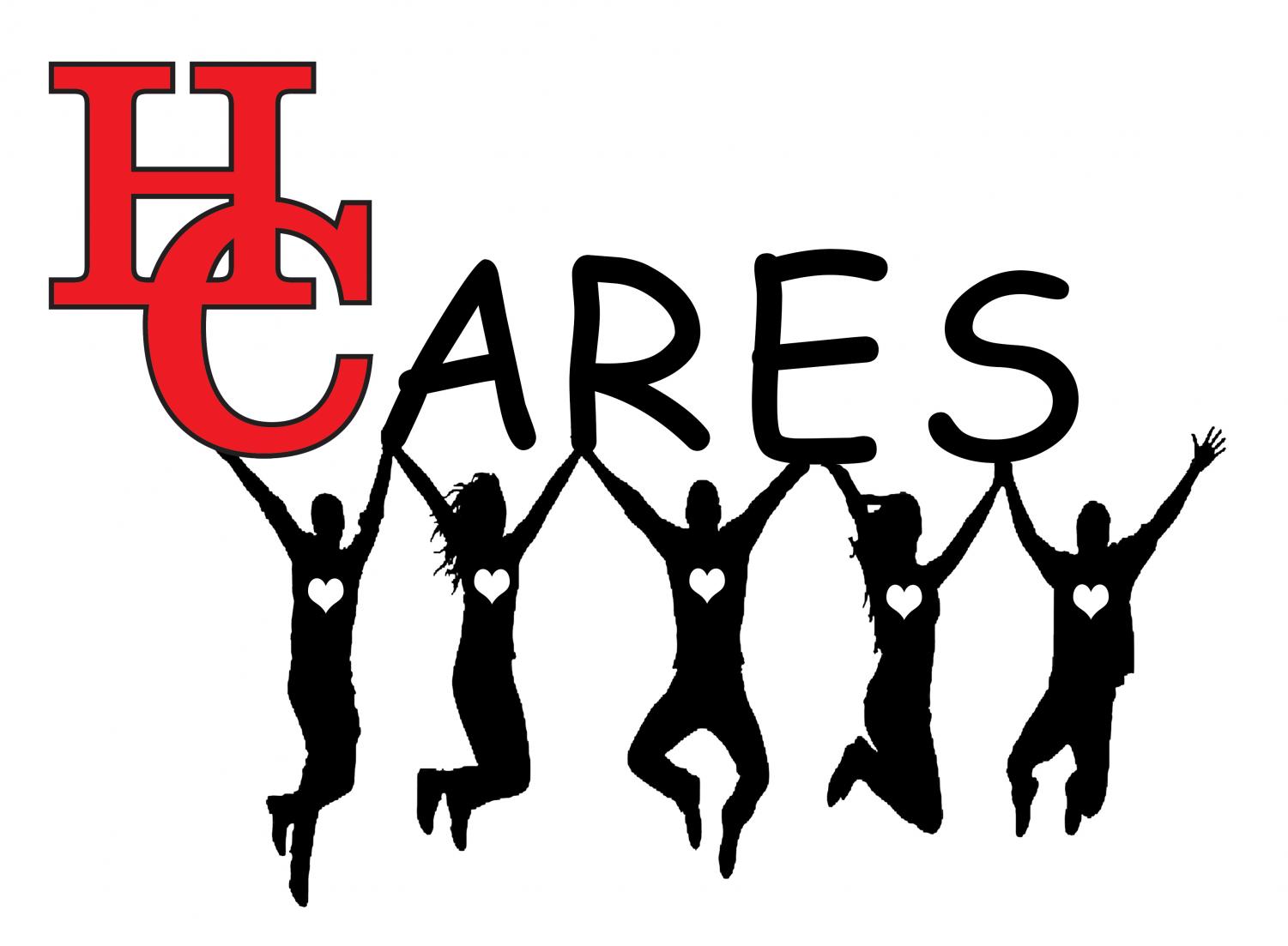 HC Cares is an acronym meaning, “Hunterdon Central Community Attunement Relationships, Resiliency Empathy Sustainability.” The schools’ goal is to make sure every student is safe and in a healthy state of mind through HC Cares.
HC Cares is an acronym meaning, “Hunterdon Central Community Attunement Relationships, Resiliency Empathy Sustainability.” The schools’ goal is to make sure every student is safe and in a healthy state of mind through HC Cares.
Dr. Carol Webb the director of Special Education at HCRHS firmly believes in the message of the HC Cares program. “One of the first things you need to do as a teacher before anything else is you need to create a relationship with your students,” Webb said.
The School has been working with The Center for Great Expectations and more specifically Frank Picone to implement this program at HCRHS. Edward Brandt is the acting principal at HCRHS. “[We are] working on how to employ these strategies as part of the wellness issue to help build positive behavior,” he said.
The HC Cares focuses strongly on student safety and security. The program’s goal is to fix and observe the problems of the students to prevent issues. HC Cares works with staff to coach them on how to have a common language with the students.
The steering committee led by Dr. Warren and Ms. Pardiso, have also started to plan for next year. They are asking to be involved on the 2020 climate survey that Dr. Jefferey Moore, the Superintendent of HCRHS, will be sending out. 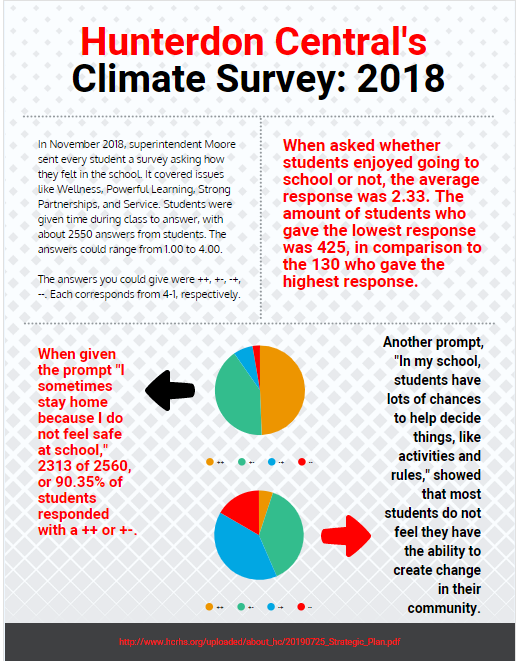
HCRHS has made this their top priority. For example, HC Cares is working to have every teacher implement it into their classroom.
One of HC Cares main goals is to leave a positive impact on everyone in the program including students, counselors, teachers and support staff.
The goal of the program is to have HC Cares a vital part of the school community. Both Warren and Paradisio agree that it will take time. They also agree that for the program to be successful it must be taught at a younger age.
“To be successful it must be taught at the lower grade levels,” Paradisio said.
Bringing Therapy Dogs Back
By Nina McManus
Hunterdon Central High School had a unique resource to help students’ with their mental health. A therapy dog named Lucy used to stay in the counselor’s office waiting for kids who needed her. Lucy helped kids relax, and allowed them to open up. With Lucy involved in students’ lives, they were given a better opportunity to get help.

Former Hunterdon Central student Gavin McManus remembers Lucy fondly. “I used to see Lucy walking in the hallway and she always seemed to cheer up whoever she was with,” he said.
Student Assistance Counselor Mrs. Stacy Heller believes having a therapy dog was effective in seeking out kids who need counseling services. “Well honestly, when we had Lucy here it really made it a whole lot easier for kids to come down and seek services,” she said. “Because although students may be reluctant to walk in the door and say I need someone to talk to, they are less reluctant to come in to just see the dog.”
Students and staff think that bringing a new therapy dog to the school will have a positive effect on the students. They believe it will bring more kids to the counselor’s office, therefore allowing more kids to get the help they need. This could improve what the school considers the ‘Climate’ of the school.
Having a therapy dog in the district is not something that can happen immediately. But in time, the school hopes to approve and bring in a new therapy dog.
Working Towards Wellness: Incorporating mindfulness in the classroom
By Sukti Patel
HC Cares emphasizes the impact teachers have on their students. The classroom experience directly affects students’ mental health. Eventually, every classroom will put students’ mental health before its academics; but a goal like that takes time. While not every teacher and staff member is behind the initiative, there are some teachers who have introduced mindfulness practices to improve their students’ mental health.
Jane Paradiso, a Family and Consumer Science teacher, has her classes do mindfulness practices. She believes strongly in helping her students who are struggling with mental health. “Mindfulness plays a really big role in relieving a students stress and making them calmer,” she said.
Except, it’s not just school where students are stressed, or their only stressor. Sometimes parents don’t realize what stress their children are under.
“I think that parents play a major role in a student’s life,” she said. “However, we as the educational community working alongside parents, should focus on helping students be calm and more resilient so that they can thrive going forward in their lives.”
Some students are behind these practices in classes. Natalia Revill, a junior, believes that teachers, staff, and parents should be working hard to diminish the negativity and stress that afflicts many students and be more open to talk about mental illness.
“Mental health is not always something that is going to be right in front of you,” she said. “If someone is struggling with depression, you are not going to see it in their eyes immediately. Some people are better at hiding it.”
In fact, according to SAMHSA (Substance Abuse and Mental Health Services Administration), 25 percent of Americans have depression and anxiety disorders and of those 25 percent, a large portion will never seek help.
“I think that adolescence is the prime period for developing social habits for mental-wellbeing,” Revill said. “If you don’t start to practice the different types of relaxation methods that help you relieve stress, it will only affect you more in the future.”
Revill believes that these steps are critical in the process of reducing mental illnesses. Different methods such as coloring, breathing exercises, and meditation, can impact a teen early on and also in their future when they most need it.
Another teacher who practices one of these mindfulness methods is Family and Consumer Science teacher Deborah Lamotta. She starts off each class by having all of her students close their eyes and focus on the relaxing sounds she plays on her phone. She does this for about 2-4 minutes in the beginning of each class to relax the students’ minds and help them forget about all of the chaos that might have happened throughout the day.
If students finish their classwork ahead of time, Lamotta has a small station set up in the corner where her students can pick up coloring pages and colored pencils to use, rather than going on their phones.
A student who was in Lamotta’s Interior Design class last school year, junior Alyssa Stomber, describes how she felt in this kind of environment.
“It was much different than some of my other classes because in other classes, we get straight to work and sometimes we need brief breaks,” she said.
Lamotta’s class was busy and work-filled, yet still relaxing. Stomber explained how these different methods can help high school students in school. “Obviously, school has a large impact.
Why is the school doing what they are doing?
By Joey Kleiner
As we look at what the school is doing to help the student wellness and mental health of the school, there have been a few reasons as to why the school is doing what they’re doing. While the school has encountered numerous tragedies and student losses over the last few years, it’s worth noting why student wellness is being looked at.
Superintendent Dr. Moore said that there were things in place before student tragedies that focused on student wellness.
Prior to Dr. Jeffrey Moore becoming the superintendent, Dr. Johanna Ruberto started questioning what the feeling of the school was.
When Dr. Moore became superintendent on April 18, 2017, one of the things he wanted to bring into focus is the wellness of the students and the school. “Students need to have strong relationships with each other and the adults at the school,” he said.
In November of 2017, Dr. Moore and the school district created the Strategic Plan. One of the priority areas of this plan was to address student wellness. Unfortunately, there have been various numbers of things that have taken hit to the overall wellness of the school.
In December of 2017, a student in the sophomore class committed suicide during the school day. When asked about why it took a suicide to bring the focus of mental health to the forefront, Dr. Moore shone a light about what they were doing beforehand with the Strategic Plan.
“We’ve been trying to take this conversation of wellness above all the specific, though really important things. Yes, self-harm and suicide is something that we have had to talk about, had to deal with, had to recover from, and have to educate about. We have to add more counseling,” he said. “But, it’s other things, it’s social media, it’s substance abuse, it’s self-medicating, and HIB [Harassment, Intimidation, and Bullying]. HIB isn’t just a three-letter word it’s a mental health and wellness thing. We can attack all of those individual things (and we have to), but the larger wellness thing for us is relationships and love and engagement in what you are doing.”
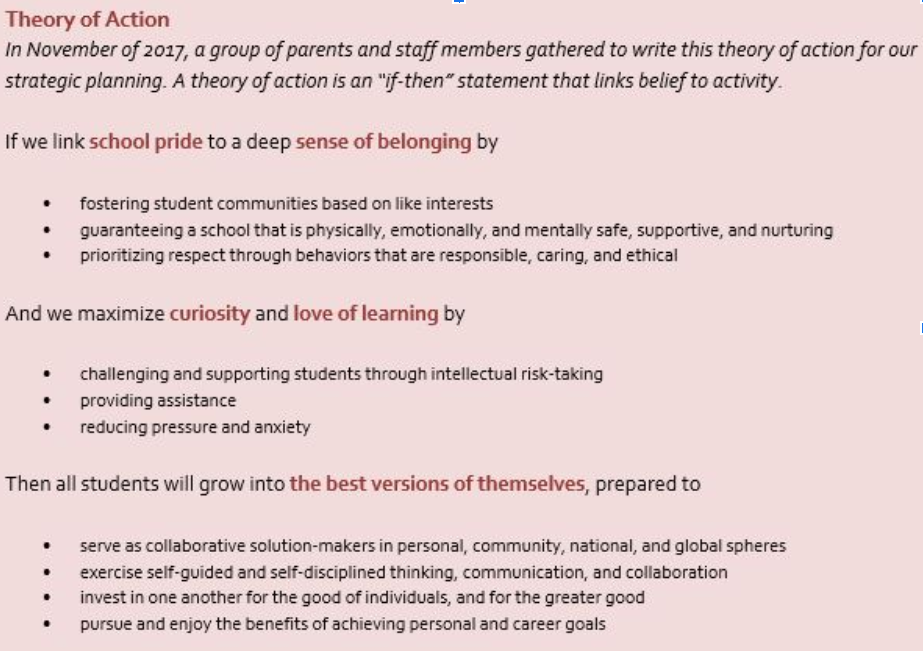
The school also realizes the need to have students at the forefront of this movement. “We are trying to change our culture and prioritize wellness,” Dr. Moore said.
The strategic plan was made to have students lead each other to the wellness summits, with everything designed to build up to that destination.
“I have not seen as passionate and activist a group of students as you guys are,” he said. “You guys have so many skills and so many sorts of good-hearted instincts that a lot of us sometimes feel like we just need to stand back and let you do that together.”
Essentially, for a couple of years now the school has been working towards making the environment more welcoming for students, as well as staff. They have been improving on this by using methods, such as the Strategic Plan to reduce mental health stigma. Also, with the HIB program, students feel safer and more secure at school.
However, this goal can only be accomplished as long as the staff plays a role, and as long as the students try to spread the word of focusing on mental health.
Student Wellness Advisory Group speaks out about the changing environment
Click on the photo below to access a grid with photos and stories
Where to Get Help and Looking Ahead
Where to Get Help
Student Assistant Counselors
Student Assistant Counselors, also known as SACs, provide assistance and private counseling for students and families that have social, emotional or mental health concerns that affect a student’s school activity. Student Assistant Counselors can assist students and families with finding appropriate community resources, such as rehabilitation, and treatment facilities if needed. Below is the contact information for the Student Assistant Counselors.
| Alexandra Buckelew | Katey Edgar | Stacy Heller | Michelle Hoff |
| (908) 284-7124 | (908) 284-7165 | (908) 284-7174 | (908) 284-7198 |
Supervisor of Counseling Services
Dana Kurilew
908-284-7160
[email protected]
Contact Information If You Or Anyone You Know Needs Help
2nd Floor of New Jersey: Provides confidential help through phone or text (1–888–222–2228)
Suicide Prevention Lifeline: 1–800–273–8255.
Looking Ahead
After this story was published, the school took several additional steps to further the work towards student wellness. This included creating a new Dean of Students position. Mr. Edward Brandt who was serving as interim principal was named Dean of Students. At a February Board of Education meeting, Dr. Moore discussed these steps and plans the district has going forward.

